

ART & SCIENCE PARTNERSHIP – The Ever – Evolving. The Revolving Museum and Beyond Benign: Art & Science Program Beyond Benign’s Art and Science Program is designed to engage artists, scientists, youth, academics, and the public in a wide range of ways including: an arts and science curriculum programyear-round public artworks, exhibitions and special eventsthe development of a Green Chemistry art and science mobileartists and scientists collaborations Led by Resident Artist and Project leader Jerry Beck, this new program combines art and science to focus on creative, social, and ecological strategies that expand Beyond Benign’s educational mission and goals.

Nationalgeographic. This set of marine community illustrations can be used as visual aids during formal or informal instruction while teaching about the marine realm.

There are three versions of each illustration: unlabeled illustrationtitled, unlabeled illustrationtitled, labeled illustration The three different versions were created in order to provide materials that best suit the needs of any educational situation.
The Sea Around Us Rachel Carson. Urban smellwheel. Ziggy Alberts - Start Over Summer Tour Artwork 2016 on Behance. Evolution of photography. Cross-section - meteoblue. Meteoblue AIR Cross-sections show a vertical cut through the atmosphere.

The standard cross-sections have 2 directions: North-South, West-East. Photography Elements Practice. 15 Dramatic Nature Illustrations by 19th-Century Scientist Ernst Haeckel. His artworks showed the wonders of evolution to a wide audience.
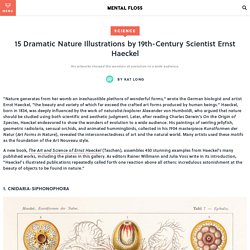
"Nature generates from her womb an inexhaustible plethora of wonderful forms," wrote the German biologist and artist Ernst Haeckel, "the beauty and variety of which far exceed the crafted art forms produced by human beings. " Haeckel, born in 1834, was deeply influenced by the work of naturalist/explorer Alexander von Humboldt, who argued that nature should be studied using both scientific and aesthetic judgment.
One ocean chapter 3. Svabhu Kohli on Behance. ShellFormStudy. Sound waves of animal noises. 6 Artists Who Use Their Art to Promote Ocean Conservation. June 8 marks World Oceans Day—a global celebration of the lungs of our planet, and all the creatures who inhabit it.
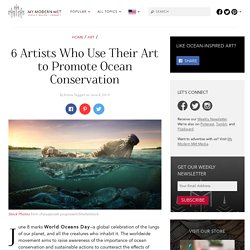
The worldwide movement aims to raise awareness of the importance of ocean conservation and sustainable actions to counteract the effects of global warming and pollution. Many people around the world are doing their part to save our seas, including contemporary artists. Through their art, they create powerful visualizations that pay homage to the beauty of the ocean, but also showcase the devastating effects of human impact. From textile art and ceramics to painting and paper sculptures, read on to discover the work of 6 artists who promote ocean conservation. Artists Who Raise Awareness About Environmental Issues with Their Art. Acoustic enrichment can enhance fish community development on degraded coral reef habitat. Study site This study was carried out during October–December 2017 in the lagoon to the south-west of Lizard Island Research Station (14°40.8′S, 145°26.4′E; Fig. 5).
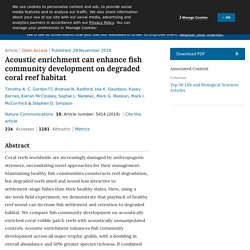
Lizard Island is a continental mid-shelf island in the northern Great Barrier Reef with an extensive surrounding fringing and lagoonal reef system. In the two years preceding this study, severe mass bleaching events caused extensive coral mortality in this area (over 60% of live coral bleached31), leading to widespread ecosystem change32,33. Study site map, showing experimental reefs and coral-rubble point. All experimental reefs were placed at a minimum distance of 100 m from their nearest neighbour, and at a fixed distance of 25 m from the nearest natural reef. Experimental design Prior to establishing experimental sites, the potential detection distance of reef-sound playback by juvenile fishes was determined using recordings at the study site.
8 Fascinating Facts About Seashells. When wandering the beaches this summer, have more to say about the shells you find than why you can hear the ocean in them.
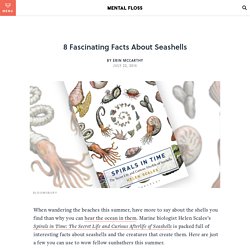
Marine biologist Helen Scales’s Spirals in Time: The Secret Life and Curious Afterlife of Seashells is packed full of interesting facts about seashells and the creatures that create them. Here are just a few you can use to wow fellow sunbathers this summer. Mollusks use calcium carbonate and proteins, secreted from their mantles, to build their shells. As a mollusk grows, so does its exoskeleton. “They are among the few animals on the planet that wander around carrying with them the same body armor they had as babies; the pointy tip or innermost whorl is the mollusk’s juvenile shell,” Scales writes.
Although there are some species with shells that are always sinistral, or left opening, nine out of 10 shells are dextral, meaning they open to the right.
Blaschka Nr. 216 - Leopold Blaschka and Rudolf Blaschka. Barents Sea. Phytoplankton bloom in the Barents Sea captured August 14, 2011.
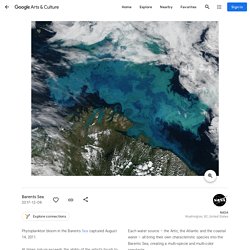
Lace Coral, Adeona cellulosa - James Ripper. Reef Bleaching - Classroom - BTN. JONES McBONES: G'day, G'day, G'day my name's Jones McBones and welcome to my Aussie Ghost Tours.

You want ghosts, we've got ghosts. Plenty of 'em. Here we have the old Melbourne Gaol. Ohhh, spooky. What about an old mine shaft in Western Australia? Let's hope it never quite gets to this. It’s complicated: coral bleaching is caused by more than just heat. Scientists in the Indian and Pacific Oceans used the El Nino of 2016 – the warmest year on record – to evaluate the role of excess heat as the leading driver of coral bleaching and discovered the picture was more nuanced than existing models showed.
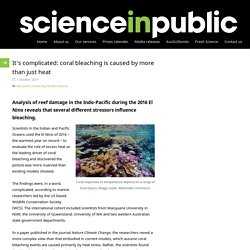
The findings were, in a word, complicated, according to marine researchers led by the US based Wildlife Conservation Society (WCS). The international cohort included scientists from Macquarie University in NSW, the University of Queensland, University of WA and two western Australian state government departments. In a paper published in the journal Nature Climate Change, the researchers reveal a more complex view than that embodied in current models, which assume coral bleaching events are caused primarily by heat stress.